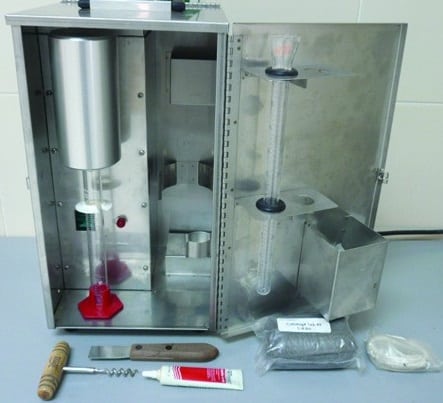Retort analysis for drilling fluid is used for determining oil, water and solids content in the mud, comprising a sample chamber assembly of known volume filled with mud. The sample chamber is put in a heating chamber to boil off the water (and oil), which passes via a condenser tube into a graduated glass measuring cylinder, where the water (and oil) volume can be recorded.

What Is The Drilling Fluid Mud Retort?
A mud distillation unit which is utilized to measure the water, oil and solids content in the drilling fluids (Water Based Mud, Oil Based Mud, Aerated Mud, Polymer Mud, ….. etc). We can say that its major components are:
- Cylindrical body equipped with a mud sample holder,
- Heating source (an oven)
- Aluminum condenser.
- A graduated glass receiver catches and measures the volumes of water and oil which have been condensed from the drilling fluid.
The common sizes of the drilling fluid retort are mainly three sizes, 10-, 20- and 50-cm3 , In other words it is the volumes of mud that will be tested through the Drilling mud Retort sample cub. At the end they give us the volume percent of water, oil and any retort solids.
Retort Analysis For Drilling Fluid Procedures
Objective
Determine the percentage of liquid (water, oil ) and solids content of any type of drilling fluid.
Retort Analysis For Drilling Fluid Equipment
- Complete retort kit
- JP volumetric receiver
- Fine steel wool
- High temperature lubricant
- Pipe cleaners
- Putty knife or spatula with blade
Procedures For Drilling Mud Retort Testing
- Collect a fluid sample and cool it to approximately 80°F (27°C).
- Pack the upper retort chamber with very fine steel wool.
- Lubricate the threads on the sample cup and condenser with a light coating of lubricating/antiseizing compound.
Note: This will prevent vapor loss through the threads and also facilitate disassembly of the equipment and cleanup at the end of the test. - Fill the retort sample cup with gas-free mud.
Note: Any trapped air will cause false readings. - Place the lid on the retort cup; rotate the lid slowly.
Note: Make sure some of the test sample is expelled through the vent hole on the lid. - Wipe off any excess mud and screw the retort sample cup into the upper retort chamber.
- Place the retort in the insulator block and put the insulator cover in place.
- Place the volumetric receiver under the drain of the condenser.
- Heat the sample until the liquid stops coming out through the condenser drain tube, or until the pilot light goes out on the thermostatically controlled units.
Note: This usually takes 45 to 60 minutes. - Remove the volumetric receiver and examine the liquid recovered.
- If Solids are in the liquid, Then whole mud has boiled over from the sample cup and the test must be repeated.
- If An emulsion band exists, Then warm the volumetric receiver slowly to 120°F (49°C).
- Allow the volumetric receiver to cool to approximately 80°F (27°C).
- Read and record the volumes of oil, or synthetic and water in the volumetric receiver.
- Calculate % by volume of the liquid and solid components of the fluid.
- a. % by volume water = mL water × 10
- b. % by volume oil/synthetic = mL oil/synthetic × 10
- c. % by volume total solids = 100 – % by volume water – % by volume oil/synthetic
- Calculate the oil:water (OWR) ratio or synthetic:water (SWR) ratio if the fluid is an oilbased or synthetic mud.
Oil fraction = (% by vol oil/synthetic) / (% by vol oil/synthetic + % by vol water)
Water fraction = 100 – oil/synthetic fraction
OWR = oil fraction:water fraction
SWR =synthetic fraction:water fraction - Calculate % by volume undissolved solids.
% by vol undissolved solids = % by vol total solids – % by vol dissolved solids - Calculate % by vol brine.
% by vol brine = % by volume water + % by volume dissolved solids - Calculate average specific gravity of solids (ASG).
ASG = {(mud density ,lb/gal)(11.98) – (%by vol oil) (sg oil) – (% by volume brine) (sg brine)} / {%by volume undissolved solids} - Calculate % by volume low-gravity solids (LGS).
%LGS = (sg wt mtl – ASG) / (sg wt mtl – sg of the LGS) x 100 - Calculate lb/bbl of LGS.
lb/bbl LGS = % LGS × sg of the LGS × 3.505 - Calculate % by volume high gravity solids (weight material).
% by vol weight material = % by vol undissolved solids – % by vol LGS - Calculate lb/bbl weight material.
lb/bbl high gravity solids (weight material) = % weight material × sg of the weight material × 3.505
Nous avons besoin d’un devis pour 01 RETORT KIT de 50 ml avec accessoires, logiciel et consommable.